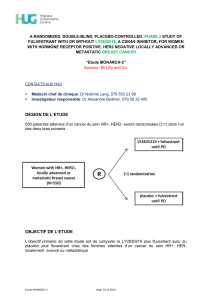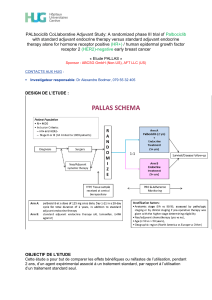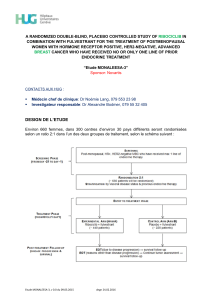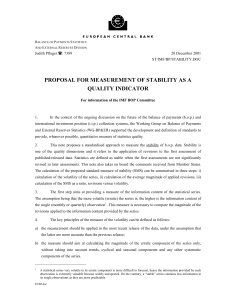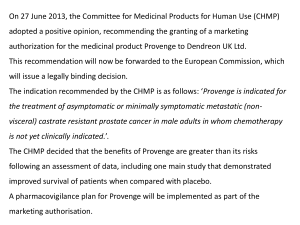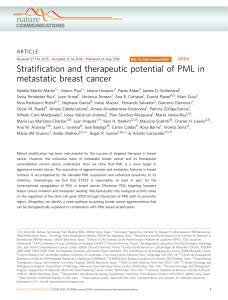New chemotherapy drugs in metastatic breast cancer Guy Jerusalem, MD, PhD
publicité
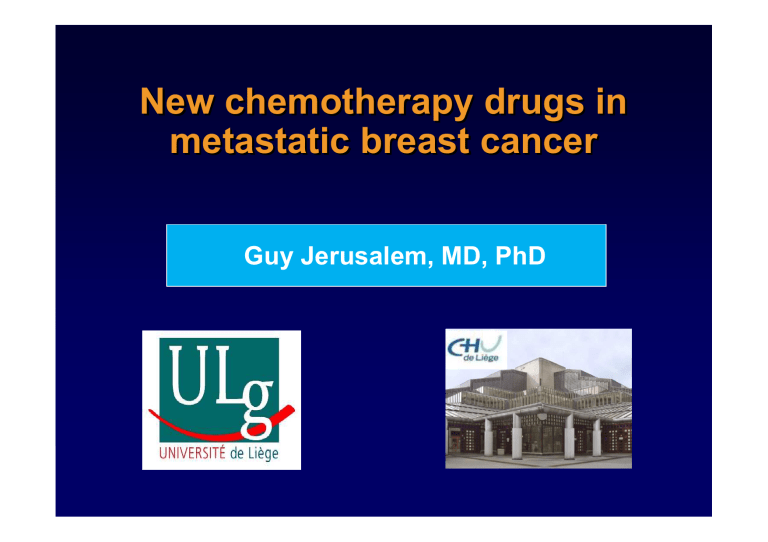
New chemotherapy drugs in metastatic breast cancer Guy Jerusalem, MD, PhD MBC Patients’ survival over time Median Median survival survival increases increases over over time, time, but but is is still still measured measured in in months months This is not yet a chronic disease New chemotherapy drugs in metastatic breast cancer •Erubiline •Nab-paclitaxel •Etirinotecan pegol (NKTR-102) Eribulin Inhibits Microtubule Dynamics in the Mitotic Spindle Eribulin 1. Inhibits microtubule growth Tubulin Polymerization Growing microtubule 3. Generation of nonproductive tubulin aggregates Eribulin Spindle Pole Shortening microtubule Tubulin Depolymerization 2. No measurable effect on shortening (at relevant concentrations) Adapted from Jordan MA et al. Mol Cancer Ther 2005; 4:1086-1095. Nonproductive tubulin aggregates Eribulin Blocks Microtubule Growth by Binding to Microtubule Ends Eribulin binds to (+) ends (+) end Eribulin α β Vinblastine binds to (+) ends and along sides (+) end Paclitaxel binds to inside surface Vinblastine (+) end Paclitaxel β α (-) end (-) end (-) end Modified from Jordan MA and Wilson L, Nat RevCancer. 2004;4:253-65, and Smith JA, Biochemistry, 2010:49, 1331-1337 TPC treatment received EMBRACE: Progression-free survival 9 Grade 3 and 4 AEs*: Study design Progression-free survival Overall survival Overall survival by receptor status nab Paclitaxel •Paclitaxel bound to albumin in a nanoparticle • Increases drug selectivity for tumor cells (albumin intake mechanisms) •No routine steroid or antihistamine premedication required, no toxic solvents Gradishar W et al. J Clin Oncol. 2005;23:7794-7803 Nab-paclitaxel: Proposed mechanism of action Nab-paclitaxel Tumour cells Desai. Drug Delivery Report 2007/8:16th Ed, 37-41; Desai et al. CCR 2006;12:1317-24 Phase III Trial Albumin-Bound Paclitaxel vs. Paclitaxel in MBC Albumin-bound paclitaxel: 260 mg/m2 q3w; Paclitaxel:175 mg/m2 q3w Albumin-Bound Paclitaxel N=229 Overall Response Rate Paclitaxel N=225 P-Value 33% 19% .001 Time to Progression 23.0 wk 16.9 wk .006 Grade 4 Neutropenia 9% 22% <.001 10%* 2% <.001 Grade 3 Sensory Neuropathy * Median time to improvement: 22 days Gradishar W et al. J Clin Oncol. 2005;23:7794-7803 Approval/indication in Europe Based on the results of the Phase III study, nab-paclitaxel received EMA approval at a dose of 260 mg/m2 Q3W for the treatment of MBC in adult patients who have failed 1st-line treatment for metastatic disease and for whom standard, anthracycline-containing therapy is not indicated Gradishar W et al. JCO 2005;23:7794-803 ABRAXANE® SPC. Available at: http://www.medicines.org.uk/emc/document.aspx?documentid=21384&docType=SPC Randomized Phase II study: Nab-paclitaxel Q3W vs QW vs docetaxel in 1st-line MBC Investigator assessment Independent assessment 100 90 80 B vs D P = 0.002 ORR % 70 60 50 C vs D P < 0.001 A vs D NS 40 30 20 10 0 300 mg/m2 Q3W (A: n = 76) A vs B; p=0.024 A vs C; p=0.002 B vs C; NS P values are for investigator assessment 100 mg/m2 QW 3/4 (B: n = 76) 150 mg/m2 QW 3/4 (C: n = 74) Docetaxel 100 mg/m2 Q3W (D: n = 74) Nab-paclitaxel Gradishar W et al. JCO 2009;27:3611-9 Randomized Phase II study: OS 1.00 Median vs OS docetaxel (months) Regimen p=0.047* Probability of survival 0.75 0.50 0.25 A. Nab-paclitaxel 300 mg/m2 Q3W 27.7 – B. Nab-paclitaxel 100 mg/m2 QW 3/4 22.2 – C. Nab-paclitaxel 150 mg/m2 QW 3/4 33.8 HR 0.688 D. Docetaxel 100 mg/m2 Q3W 26.6 – C vs B: p=0.008; HR 0.575 0.00 0 10 20 30 40 50 *3 degrees of freedom test for overall difference No p value is reported where a treatment difference is not detected by stepdown methodology Gradishar W et al. Clin Breast Cancer. 2012;12:313-21 Nab-paclitaxel improves OS vs traditional taxanes in patients with poor prognostic factors* Visceral dominant disease Short DFI Median OS (months) All comparisons NS All comparisons NS HR 01.251 p=0.268 Nab-paclitaxel 260 mg/m2 Q3W Conventional paclitaxel 175 mg/m2 Q3W Nab-paclitaxel 300 mg/m2 Q3W (A) *Most comparisons did not reach statistical significance due to small sample sizes HR 0.942 p=0.819 Nab-paclitaxel 100 mg/m2 QW 3/4 (B) Nab-paclitaxel 150 mg/m2 QW 3/4 (C) Docetaxel 100 mg/m2 Q3W (D) O’Shaughnessy et al BCRT 2013, April 6 [epub ahead of print] Key ongoing trials evaluating nab-paclitaxel in breast cancer Setting Study ID Description No of pt 1st line MBC SNAP NCT01746225 Randomized phase II study evaluating different nab-paclitaxel schedules in patients with HER2-/HR- (or + resistant) MBC 1st line MBC tnAcity NCT01881230 Randomized phase II/III study evaluating nab-paclitaxel + gem or carb vs gem + carb in patients with TNMBC Neoadjuvant GEPARSEPTO NCT01583426 Randomized phase III trial comparing nab-paclitaxel with solventbased paclitaxel as part of neoadjuvant chemotherapy for patients with early breast cancer 1200 Neoadjuvant GEICAM NCT01565499 Phase II, open-label, non-randomized study of nab-paclitaxel for patients with stage II and III luminal breast cancer as neoadjuvant therapy 78 Neoadjuvant ETNA NCT01822314 Randomized phase III trial comparing nab-paclitaxel with solventbased paclitaxel as part of neoadjuvant chemotherapy for patients with HER2-negative high-risk breast cancer 632 Neoadjuvant/ adjuvant ADAPT NCT01781338 Adjuvant Dynamic marker-Adjusted Personalized Therapy trial optimizing risk assessment and therapy response prediction in early cancer 4936 Adjuvant GAIN-2 NCT01690702 Phase III trial to compare intense dose-dense adjuvant treatment with EnPC to dose-dense, tailored therapy with dtEC-dtD for patients with high risk primary breast cancer 2960 Adjuvant ICE-II NCT01204437 A randomized Phase II study of EC/CMF vs nab-paclitaxel plus capecitabine as adjuvant chemotherapy for elderly patients with an increased risk for relapse of a primary carcinoma of the breast 1458 240 240 (ph 2) 550 (ph 3) www.clinicaltrials.gov Longer first-line chemotherapy duration: Substantially longer PFS (HR:0.64) Gennari et al. J Clin Oncol,2011,29:2144-2149 Longer first-line chemotherapy duration: Marginal effect on overall survival (HR:0.91) Gennari et al. J Clin Oncol,2011,29:2144-2149 SNAP trial First line chemotherapy for metastatic breast cancer UDY SCHEMA R A N D O M I Z E Induction Chemotherapy A B nab-Paclitaxel 150 mg/m2 days 1,8,15 3 cycles (28-day) C Schedule of nab-Paclitaxel administration: Maintenance Chemotherapy A nab-Paclitaxel 150 mg/m2 days 1, 15 B nab-Paclitaxel 100 mg/m2 days 1,8,15 C nab-Paclitaxel 75 mg/m2 days 1,8,15,22 In case of toxicity, dose reductions and delays are preferred to dose discontinuation SNAP Accrual and Study Duration • Target Accrual: 240 patients – (Arm A: 80, Arm B: 80, Arm C: 80) – 88% power if median PFS of any arm is at least 10 mos. compared with reference 7 mos. • Study Duration – Randomization during 30 months – Additional 12 months of follow-up after the last patient entered • BIG Supporter Trial: IBCSG (coordinating), SOLTI, ICORG, EORTC tnAcity: Study design US chair: Denise Yardley EU co-chair: Nadia Harbeck 1st line TNMBC R 1:1:1 Phase II Phase III Nab-paclitaxel 125 mg/m2 + carboplatin AUC 2 QW 2/3 (n=80) Winner of the 2 Phase II nabpaclitaxel arms (n=275) Nab-paclitaxel 125 mg/m2 + gemcitabine 1000 mg/m2 QW 2/3 (n=80) Carboplatin AUC2 + gemcitabine 1000 mg/m2 QW 2/3 (n=80) Phase II Study start: June 2013 Phase II estimated completion (primary analysis): June 2015 Phase III ‘go/no go’ decision : Sep 2015 R 1:1 Carboplatin AUC2 + gemcitabine 1000 mg/m2 QW 2/3 (n=275) Patients in Phase II will not be included in Phase III analysis Continue treatment until PD or unacceptable toxicity tnAcity: Study endpoints Phase II Phase III • Primary: • Primary: – PFS (investigator assessment) • Secondary – ORR – % of pts initiating cycle 6 – OS – Safety – PFS (central assessment) • Secondary – ORR – OS – DCR – DoR – Safety NKTR-102: Etirinotecan pegal • NKTR-102 is the first long-acting topoisomerase I-inhibitor • Targets tumor tissue through Enhanced Permeability and Retention (EPR) effect • Optimized pharmacokinetic profile with continuous tumor exposure but with reduced peak exposures • High response rates in advanced disease and poor prognosis tumors 30 NKTR-102: The First Long-Acting Topoisomerase I-Inhibitor 31 NKTR-102: Mechanism of Action: First-generation topoisomerase I-inhibitors have a high initial peak concentration and short half-life 32 NKTR-102: Mechanism of Action: NKTR-102’s design results in a lower initial peak concentration of active topoisomerase I-inhibitor in the blood 33 Phase 2 Study Design: Randomized to 2 Schedules of NKTR-102 • Primary Efficacy Objective: — Determine the objective response rate (ORR) by RECIST v 1.0 — Determine the optimal schedule of NKTR-102 in breast cancer • Secondary Objectives: PFS, OS and safety Metastatic Breast Cancer 145 mg/m2 q14d Objective Response Rate N=70 <2 Regimens for Metastatic Disease Primary Endpoint: 145 mg/m2 q21d (RECIST) Statistical Hypotheses: H0 ORR (RECIST version 1.0) ≤ 5% and Ha ORR ≥ 20%. (Type 1 error = 0.029; type 2 error = 0.145) 34 Demographics in Phase 2 Study NKTR-102 145 mg/m2 q14 days N=35 NKTR-102 145 mg/m2 q21 days N=35 53 (33-83) 56 (37-77) Women, No. (%) 34 (97) 35 (100) Ethnic origin, No. (%) White Black Asian Other 31 (89) 2 (6) 1 (3) 1 (3) 33 (94) 2 (6) 0 0 ECOG PS, No. (%) 0 1 15 (43) 20 (57) 13 (37) 22 (63) Postmenopausal, No. (%) 24 (71)* 29 (83) Time from initial diagnosis to first dose, median yr (range) 4 (0-15) 5.4 (1-19) Time from initial diagnosis to metastatic disease, median yr (range) 1.5 (0-7) 2 (0-12) Receptor status ER+ PR+ HER2+ ER-/PR-/HER2- (triple-negative) 21 (60) 11 (31) 3 (9) 11 (31) 20 (57) 13 37) 2 (6) 10 (29) Visceral disease 28 (80) 32 (91) Age, median yr (range) *Out of women only (n=34). ECOG PS; Eastern Cooperative Oncology Group performance status; ER, estrogen receptor; HER2, human epidermal growth factor receptor 2; PR, progesterone receptor. Awada A, et al. Lancet Oncol. 2013;14:1216-1225 35 Demographics in Phase 2 Study (cont.) NKTR-102 145 mg/m2 q14 days N=35 NKTR-102 145 mg/m2 q21 days N=35 Previous cytotoxic regimens in metastatic setting, median No.(range) 1 (0-3) 2 (0-2) Any previous cytotoxic regimens in the metastatic setting, No. (%) 1 previous cytotoxic regimen 2-3 previous cytotoxic regimens 34 (97) 17 (49) 17 (49) 34 (97) 9 (26) 25 (71) Previous systemic treatments*, No. (%) Taxane Anthracycline Capecitabine Anthracycline/taxane Anthracycline/taxane/capecitabine Previous cytotoxic (neo)adjuvant therapy Previous adjuvant anthracycline Previous adjuvant taxane Previous adjuvant anthracycline and/or taxane 35 (100) 31 (89) 9 (26) 23 (66) 8 (23) 27 (77) 15 (43) 9 (26) 19 (54) 35 (100) 31 (89) 10 (29) 21 (60) 10 (29) 24 (69) 17 (49) 5 (14) 18 (51) *In adjuvant or metastatic setting. Awada A, et al. Lancet Oncol. 2013;14:1216-1225 36 NKTR-102: Metastatic Breast Cancer Phase 2 Final Results • Single-agent NKTR-102 demonstrated a 29% ORR in heavily pretreated (median 2 prior lines of therapy) advanced metastatic breast cancer — PFS: 4.7 months — Median OS: 10.3 months — Progression-free at 6 months: 35.5% • ORR was maintained in heavily pretreated and poor prognosis subsets — A/T/C pre-treated: 33% — Triple negative: 33% — Visceral disease: 30% • Activity in the 3 main subtypes: TNBC, HER2+, Hormone+ 37 NKTR-102: Metastatic Breast Cancer Phase 2 Final Results • Most common Grade 3/4 toxicity was diarrhea (21%) — Typically occurring after approximately 3 months of therapy for both schedules • 21-day schedule better tolerated and more efficacious — ORR: 29%; PFS: 5.6 months, OS: 13.1 months — Selected for Phase 3 BEACON study 38 Summary of Treatment-emergent Adverse Events (TEAEs) Most Common TEAEs (≥ 15%), No. (%) NKTR-102 145 mg/m2 q14 days n=35 NKTR-102 145 mg/m2 q21 days n=35 All Grades Grade 3–4 All Grades Grade 3–4 Diarrhea 24 (69) 7 (20) 22 (77) 8 (23) Nausea 25 (71) 2 (6) 26 (74) 1 (3) Fatigue 15 (43) 5 (14) 18 (51) 3 (9) Vomiting 19 (54) 3 (9) 14 (40) 2 (6) Decreased appetite 14 (40) 1 (3) 12 (34) 0 Constipation 14 (40) 0 9 (26) 0 Abdominal pain 7 (20) 1 (3) 8 (23) 0 Blurred vision 9 (26) 0 6 (17) 0 Dehydration 7 (20) 3 (9) 6 (17) 4 (11) Neutropenia 6 (17) 4 (12) 7 (20) 4 (11) Alopecia 7 (20) 0 4 (11) 0 Anemia 6 (17) 1 (3) 4 (11) 1 (3) Decreased weight 3 (9) 0 7 (20) 0 Dyspnea 6 (17) 1 (3) 3 (9) 0 • 2 possible treatment-related deaths occurred (both in q14 day): sepsis and acute renal failure following diarrhea. Awada A, et al. Lancet Oncol. 2013;14:1216-1225. 39 NKTR-102: New Mechanism of Action in Metastatic Breast Cancer The Challenge of Treating Metastatic Breast Cancer: Overlapping Toxicities and Resistance with Existing Treatments • Most therapies used in MBC disrupt microtubules and have overlapping toxicities • In Phase 2, NKTR-102 had activity as single agent in breast cancer patients with poor prognosis — Primary toxicity is diarrhea — Low rates of neutropenia — No neuropathy — Little alopecia — No cardiac toxicity Currently no other topoisomerase I inhibitors in development or approved for the treatment of breast cancer 40 Time Course of Diarrhea and Neutropenia Diarrhea (≥ Grade 3) Cycle 1 and/or 2 Cycle 3 and/or 4 Cycle 4+ Onset, median days (range) [# cycle] Duration, median days (range) Neutropenia (≥ Grade 3) Cycle 1 and/or 2 Cycle 3 and/or 4 Cycle 4+ Onset, median days (range) [# cycle] Duration, median days (range) NKTR-102 145 mg/m2 q14 days N=35 NKTR-102 145 mg/m2 q21 day N=35 9% 0% 11% 88 (1-121) [6] 8.5 (1-16) 3% 6% 14% 90 (8-107) [5] 16 (2-39) 3% 0% 9% 98 (15-188) [6.5] 12 (6-15) 3% 6% 3% 60 (28-140) [3] 9.8 (6-14) Anti-diarrheals given therapeutically; no prophylactic anti-diarrheals administered Source: Data as of 09May2011 41 BEACON Phase 3 Registration Study of NKTR-102 in Metastatic Breast Cancer Global enrollment completed ahead of schedule in August 2013; Topline data expected end of 2014 or early 2015 42 Single Agent Chemotherapy Outcomes in Refractory MBC Author Agent RR Prior Therapy PFS (mo.) A T C Perez JCO 2007 Ixabepilone x x x 11% 3.1 Cortes JCO 2010 Eribulin x x x 9% 2.6 Cortes Lancet 2011 Eribulin x x x/‒ 13% 3.7 NKTR-102 x x x/‒ 29% 4.7 x x x/‒ 29% 5.6 Awada Lancet Oncology 2013 (q14d + q21d) NKTR-102 (q21d only) A = Adriamycin T = Taxane C = Capecitabine 43 New chemotherapy drugs in metastatic breast cancer •Erubiline •Nab-paclitaxel •Etirinotecan pegol (NKTR-102)








